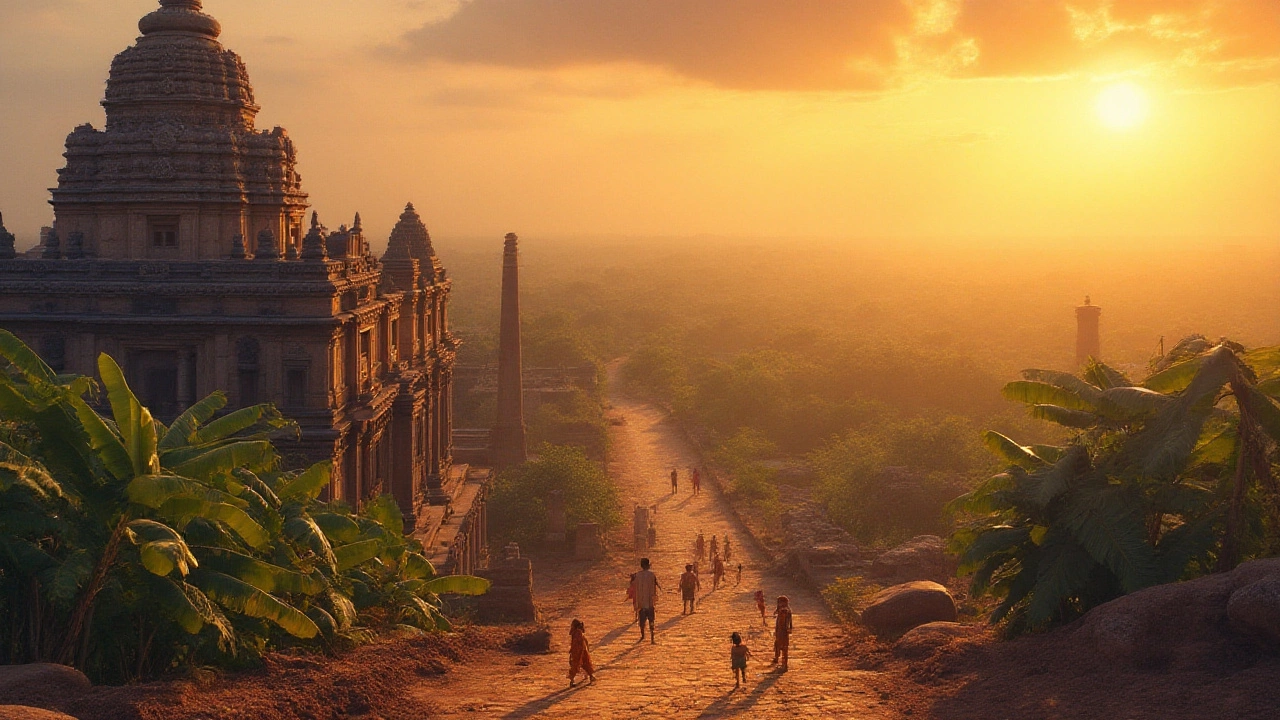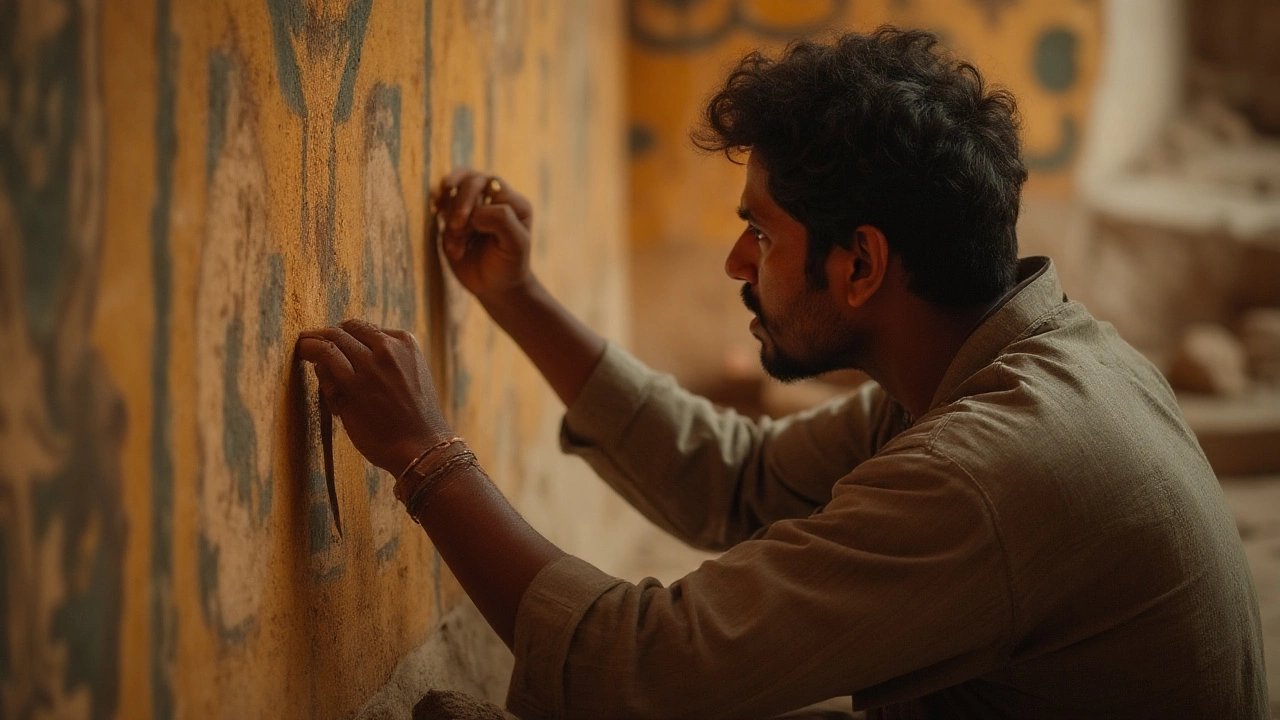Why Heritage Sites Matter in India: Culture, History, and Must-Know Facts

- Aug, 2 2025
- 0 Comments
- Aaron Blackwood
Imagine standing beneath the carved pillars of the Sun Temple in Konark. Sunlight streaks through time-worn stone, and for a moment, you feel like you’ve slipped into another century. That’s the kind of magic India’s heritage sites create. These places do more than just look pretty or pull in crowds—they keep ancient stories and cultures alive, sitting smack in the middle of today’s hustle. India’s heritage sites aren’t just monuments. They’re anchors for identity, reminders that the world’s oldest traditions can stand solid no matter what modern life throws at them.
The Heartbeat of Indian Culture
If you try to sum up Indian culture in a single afternoon, you’ll come up short. India is a living tapestry of foods, festivals, languages, and beliefs. What ties much of it together? Heritage sites. These temples, forts, palaces, and ruins aren’t stuck in the past—they shape everyday life in ways that go way beyond history textbooks.
Step inside the Taj Mahal and you’re not just seeing a mausoleum. You’re feeling centuries of emotional stories, from Mughal romance to colonial fascination. At Hampi’s ruins, you meet echoes of lost empires and the hustling energy of modern pilgrims. In Varanasi, river ghats serve as stages for life’s rituals, from morning baths to final farewells.
These sites are storytellers. They show how architecture can blend Hindu, Islamic, Jain, or Buddhist influences—all witnessed in one city or even a single building. Check out the Qutub Minar in Delhi: started by a Delhi Sultan and finished by his successors, it mixes Persian patterns into its design and features verses in Arabic. India’s temples, like Meenakshi in Madurai or the Golden Temple in Amritsar, pulse with religious traditions while hosting thousands every day, blending old faith with the reality of crowded cities and selfie-snapping tourists.
Heritage sites even shape art and pop culture. Bollywood blockbusters get shot at these sites, and you’ll spot their images on currency notes, in schoolbooks, and at festivals. The crafts sold in Jaipur’s old bazaars echo patterns from Amber Fort’s walls. Even things like yoga retreats and classical dance performances often trace their roots back to ancient schools and temple grounds.
Protecting this vibe matters because once a site fades away, the stories start to slip too. When you visit or even learn about heritage places, you’re helping keep centuries-old traditions alive. And if you can’t hop on a plane, virtual tours from big sites like the ASI (Archaeological Survey of India) pop heritage right onto your screen—how’s that for mixing ancient and modern?
India’s diversity goes deeper than just geography or language. From Ladakh’s Buddhist monasteries clinging to snowy cliffs, to Kerala’s colonial forts ringed by palm trees, each heritage site packs a different flavor. They’re proof that Indian culture comes in thousands of varieties, all worth keeping around.

Why Heritage Sites Are Crucial for Indian History
Heritage sites aren’t just pretty faces—they’re the closest thing to a time machine you’ll find. These places help turn massive, head-spinning history into something personal and real. Through worn-out stone and surviving murals, you see the fingerprints of kings, explorers, tradespeople, and everyday folks who shaped the country over thousands of years.
India’s UNESCO World Heritage Sites—a whopping 42 as of 2025—offer a lineup you can’t find anywhere else. You get ancient Buddhist caves at Ajanta and Ellora with their secret paintings, the Iron Pillar at Qutub complex (which still hasn’t rusted after 1600 years), and the wild tangle of roots swallowing temples at Hampi or Mahabalipuram. Each one isn’t just famous; it solves a piece of the puzzle: Who lived here hundreds or thousands of years ago? What technologies and art did they use? How did they handle everything from invasions to climate to building gigantic structures?
The Taj Mahal pulls in around 6-8 million visitors a year. But its story—built by Shah Jahan for his favorite wife, Mumtaz Mahal—digs into raw human emotion at a scale only a place like this can deliver. Stand at the Ganges ghats in Varanasi and you’re at a crossroads of history, religion, and daily life that’s continued, almost unchanged, for millennia.
Sometimes it’s less about big headlines and more about everyday life. Villages near sites like Khajuraho or Fatehpur Sikri preserve local crafts, lifestyle, and oral histories that don’t turn up in your average museum. Schools visit these sites to teach students about India’s roots, making history lessons hands-on and unforgettable.
Here’s a quick look at some headline figures for India’s top heritage spots:
| Heritage Site | Year Designated UNESCO | Approx. Annual Visitors |
|---|---|---|
| Taj Mahal | 1983 | 7 million |
| Qutub Minar | 1993 | 3.5 million |
| Ajanta Caves | 1983 | 500,000 |
| Red Fort Complex | 2007 | 2 million |
| Sun Temple, Konark | 1984 | 1 million |
It’s not all about the past though. Indian heritage sites make today’s headlines too, especially as governments and local people tackle everything from climate change to overtourism. Some sites are threatened by pollution, encroaching development, or even social conflicts. That makes responsible travel a big deal. If you visit, skip carving your initials or feeding monkeys—these may seem small, but they pile up fast. Stick to walkways, avoid flash photography, and always listen to site guides. Most big sites use your ticket fee for conservation, so it’s worth every rupee.
Conservation groups, local volunteers, even schoolchildren have rolled up their sleeves to clean and protect these sites. Special projects use 3D scanning and holograms to digitally preserve fragile details for future generations. Sometimes they even uncover hidden artwork after centuries. The truth is, if one part of India’s heritage story disappears, everyone—from future travelers to school kids—loses out.

Travel Tips and Insider Advice for Exploring India’s Heritage
If you’re planning a visit to heritage sites India offers, a little smart planning goes a long way. India’s most famous spots like the Taj Mahal, Jaipur’s Amer Fort, or Goa’s old churches can get busy, especially during holidays and weekends. Try visiting in the early morning or late afternoon when crowds thin out and the sunlight looks unreal on the carved stones. Most sites have designated walkways, and sticking to them protects both you and the ancient structures.
Don’t rush through multiple sites in a day—the best discoveries often come when you slow down. Want to skip ticket lines? Book in advance online whenever possible. For big destinations, hiring a local guide unlocks stories you’d never guess from a plaque or brochure, and sometimes they know secret photo spots or quieter spaces for reflection.
If you’re traveling with kids or people with mobility challenges, check site access ahead of time. Some ancient places have lots of stairs or uneven stones—think Hampi or Jaisalmer’s fort. But you’ll find ramps, accessible toilets, and easy parking at newer or recently upgraded sites, like Sanchi Stupa or Delhi’s Red Fort. Always bring a hat, refillable water bottle, sunscreen, and sturdy shoes. At religious sites, dress modestly and expect to remove your shoes before entering central areas.
Bargain-hunting for souvenirs? Look for locally made crafts right outside heritage entrances. These range from Agra’s marble inlay coasters to leather-bound journals in Mysore. Usually, the money goes straight to local artists who’ve passed down these skills for generations. Official site shops tend to skip the tourist-trap junk and offer things you’ll be glad to take home.
Some insider hacks for seeing India’s heritage without any stress:
- Go mid-week for quieter spots.
- Join early morning photo walks—many places like Jaipur or Varanasi offer these.
- Public transport or ride-shares can help you skip parking chaos.
- Always check for site maintenance schedules online—sometimes key parts are closed for restoration.
- Many temples and palaces have light-and-sound shows at night. Book these early for a different vibe.
- If you’re keen to visit lesser-known gems, try Orchha in Madhya Pradesh, Ziro in Arunachal Pradesh, or Badami in Karnataka.
- Respect local customs—ask before snapping photos of people or ceremonies.
If you’re there for a festival, you’re in for a thrill—but so are a million others. Book accommodation nearby, arrive well before schedule, and pack snacks and spare cash (ATMs near major sites can run dry on busy days). Each festival reinvents a site’s meaning and turns a simple visit into a once-in-a-lifetime memory.
A growing number of heritage sites now run creative initiatives like guided birdwatching, yoga classes, or traditional music sessions. These up the experience, especially if you’re tired of taking selfies and want something a bit richer. Check ahead on official tourism boards or even Instagram pages—these often list pop-up events and special open days.
Don’t forget—every ticket, every story shared, helps India’s heritage survive the next century. Whether you’re planning a trip or daydreaming from the other side of the world, these sites connect you to a story that’s much bigger, older, and richer than anything you’ll find on a screen. The monuments are still standing. Their secrets just need curious visitors who care.